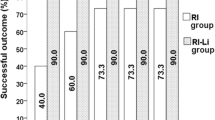Abstract
Purpose
To study the effect of adjuvant lithium on serum thyroxine (T4) concentrations in patients treated with radioactive iodine (RAI) therapy in our environment.
Methods
This was a prospective simple randomized comparative, experimental cohort study of patients with hyperthyroidism referred for RAI ablation therapy in the two main academic hospitals in Johannesburg between February 2014 and September 2015.
Results
Amongst the 163 participants in the final analysis, 75 received RAI alone and 88 received RAI with lithium. The difference in mean T4 concentrations at 3 months between the RAI-only group (17.67 pmol/l) and the RAI with lithium group (11.55 pmol/l) was significant with a small effect size (U = 2328.5, Z = −2.700, p = 0.007, r = 0.01). Significant decreases in T4 concentrations were observed as early as 1 month after RAI (p = 0.0001) in the RAI with lithium group, but in the RAI-only group, significant decreases in T4 concentrations were observed only at 3 months after RAI therapy (p = 0.000). Women and patients with Graves’ disease who received RAI with adjuvant lithium also showed significant decreases in T4 concentrations at 1 month (p = 0.002 and p = 0.003, respectively).
Conclusion
Adjuvant lithium leads to an earlier and better response to RAI therapy with lower T4 concentrations that are achieved earlier. This earlier response and decrease in T4 concentrations were noted in patients with Graves’ disease and nodular goitre, and in women with hyperthyroidism who received adjuvant lithium therapy.



Similar content being viewed by others
References
Allahabadia A, Daykin J, Sheppard MC, Gough SC, Franklyn JA. Radioiodine treatment of hyperthyroidism – prognostic factors for outcome. J Clin Endocrinol Metab. 2001;86(8):3611–7.
Jameson JL, Weetman AP. Diseases of the thyroid gland. In: Kasper DL, Braunwald E, Fauci AS, Hauser SL, Longo DL, Jameson JL, editors. Harrison’s principles of internal medicine. 16th ed. London: McGraw Hill; 2005. p. 2104–26.
Nordyke RA, Gilbert Jr FI. Optimal Iodine-131 dose for eliminating hyperthyroidism in Graves’ disease. J Nucl Med. 1991;32:411–6.
Santos RB, Romaldini JH, Ward LS. Propylthiouracil reduces the effectiveness of radioiodine treatment in hyperthyroid patients with Graves' disease. Thyroid. 2004;14(7):525–30. doi:10.1089/1050725041517093.
Vijayakumar V, Ali S, Nishino T, Nusynowitz M. What influences early hypothyroidism after radioiodine treatment for Graves’ hyperthyroidism? Clin Nucl Med. 2006;31(11):688–9. doi:10.1097/01.rlu.0000242213.26839.20.
Bogazzi F, Bartalena L, Brogioni S, Scarcello G, Burelli A, Campomori A, et al. Comparison of radioiodine with radioiodine plus lithium in the treatment of Graves' hyperthyroidism. J Clin Endocrinol Metab. 1999;84(2):499–503. doi:10.1210/jcem.84.2.5446.
Lee SL. Radioactive iodine therapy. Curr Opin Endocrinol Diabetes Obes. 2012;19(5):420–8. doi:10.1097/MED.0b013e328357fa0c.
Ziessman HA, O’Malley J, Thrall J. Nuclear medicine: the requisites. 4th ed. Philadelphia: Elsevier Saunders; 2014. p. 66–97.
Atmaca A, Dogan S, Dagdelen S, Gurlek A, Bayraktar M, Adalar N. Symptomatic treatment of Graves hyperthyroidism with lithium in states of thionamide adverse reactions. Endocrinologist. 2004;14(6):317–20. doi:10.1097/01.ten.0000146399.37196.12.
Lazarus JH. Lithium and thyroid. Best Pract Res Clin Endocrinol Metab. 2009;23(6):723–33. doi:10.1016/j.beem.2009.06.002.
Bogazzi F, Giovannetti C, Fessehatsion R, Tanda ML, Campomori A, Compri E, et al. Impact of lithium on efficacy of radioactive iodine therapy for Graves' disease: a cohort study on cure rate, time to cure, and frequency of increased serum thyroxine after antithyroid drug withdrawal. J Clin Endocrinol Metab. 2010;95(1):201–8. doi:10.1210/jc.2009-1655.
Turner JG, Brownlie BE, Rogers TG. Lithium as an adjunct to radioiodine therapy for thyrotoxicosis. Lancet. 1976;307(7960):2.
Bogazzi F, Bartalena L, Campomori A, Brogioni S, Traino C, De Martino F, et al. Treatment with lithium prevents serum thyroid hormone increase after thionamide withdrawal and radioiodine therapy in patients with Graves' disease. J Clin Endocrinol Metab. 2002;87(10):4490–5. doi:10.1210/jc.2002-020580.
Martin NM, Patel M, Nijher GM, Misra S, Murphy E, Meeran K. Adjuvant lithium improves the efficacy of radioactive iodine treatment in Graves' and toxic nodular disease. Clin Endocrinol (Oxf). 2012;77(4):621–7. doi:10.1111/j.1365-2265.2012.04385.x.
Bahn Chair RS, Burch HB, Cooper DS, Garber JR, Greenlee MC, Klein I, et al. Hyperthyroidism and other causes of thyrotoxicosis: management guidelines of the American Thyroid Association and American Association of Clinical Endocrinologists. Thyroid. 2011;21(6):593–646. doi:10.1089/thy.2010.0417.
Gayed I, Wendt J, Haynie T, Dhekne R, Moore W. Timing for repeated treatment of hyperthyroid disease with radioactive iodine after initial treatment failure. Clin Nucl Med. 2001;26(1):1–5.
Bonnema SJ, Hegedus L. Radioiodine therapy in benign thyroid diseases: effects, side effects, and factors affecting therapeutic outcome. Endocr Rev. 2012;33(6):920–80. doi:10.1210/er.2012-1030.
Andrade VA, Gross JL, Maia AL. The effect of methimazole pretreatment on the efficacy of radioactive iodine therapy in Graves’ hyperthyroidism: one-year follow-up of a prospective, randomized study. J Clin Endocrinol Metab. 2001;86(8):3488–93.
Bal CS, Kumar A, Pandey RM. A randomized controlled trial to evaluate the adjuvant effect of lithium on radioiodine treatment of hyperthyroidism. Thyroid. 2002;12(5):399–405. doi:10.1089/105072502760043486.
Płazińska M, Królicki L, Bąk M. Lithium carbonate pre-treatment in 131-I therapy of hyperthyroidism. Nucl Med Rev Cent East Eur. 2011;14(1):3–8.
Author information
Authors and Affiliations
Corresponding author
Ethics declarations
Conflicts of interest
None.
Ethical approval
All procedures performed in studies involving human participants were in accordance with the ethical standards of the institutional and national research committee and with the principles of the 1964 Declaration of Helsinki and its later amendments or comparable ethical standards. Ethics clearance certificate number: M130846.
Informed consent
Informed consent was obtained from all individual participants included in the study.
Rights and permissions
About this article
Cite this article
Hammond, E.N., Vangu, MDT.H.W. Effect of adjuvant lithium on thyroxine (T4) concentration after radioactive iodine therapy. Eur J Nucl Med Mol Imaging 43, 1980–1987 (2016). https://doi.org/10.1007/s00259-016-3388-3
Received:
Accepted:
Published:
Issue Date:
DOI: https://doi.org/10.1007/s00259-016-3388-3




